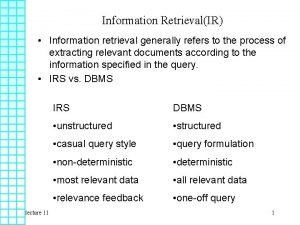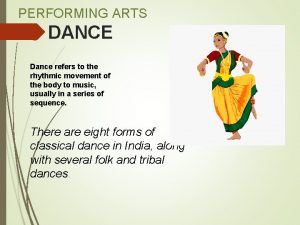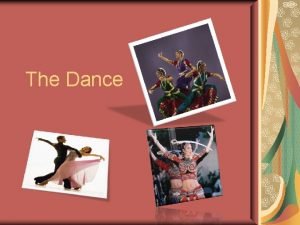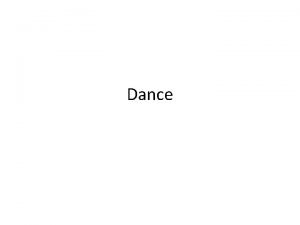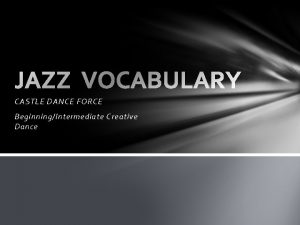DANCE Dance generally refers to human movement either








- Slides: 8

DANCE Dance generally refers to human movement either used as a form of expression or presented in a social, spiritual or performance setting. Dance methods of non-verbal communication , motion in inanimate objects and certain musical forms or genres.

• concert dance Ballet Performance dance classical Neoclassical • Dance theatre • Modern dance Contemporary improvisation • Musical theatre Lyrical dance • Jazz • Cabaret physical theatre Folk dance Ceremonial dance • Ritual dance Dance Traditional dance Thai classical dance cultural aesthetic artistic competitions Ballroom dance sport Tap dance Irish dance • Butoh (Japanese) Nightclub dance Street dance • Hip hop Dance Master • Dance technology Dance notation Dance occupation Dance therapy social moral • Belly Dance Erotic dancing • Can-can Dance network • Cage dance • Go-go dance /assosiation • Sexercise • Striptease

Ballet • Ballet styles Classical ballet Romantic Ballet Neoclassic ballet modern ballet contemporary ballet.

Choreographer solo dancers Partner dance pas de deux duet couples Ballet mistress or Ballet master Prima ballerinas Ballerinas Principal dancers Character dancers Répétiteur or Dance notator Soloists pas de trois 3 pas de quatre 4 groups of people corps de ballet

Modern dance free dance Isadora Duncan, Ruth St. Denis, Doris Humphrey and Martha Graham Expressionist dance. Francois Delsarte, Émile Jaques-Dalcroze and Rudolf von Laban

Contemporary Dance Postmodern dance is a 20 th century concert dance Contact Improvisation Dance improvisation methods of dance composition the work of Rudolf Laban, Merce Cunningham, Martha Graham

Elements of Choreography elements of time, energy and space Time: rhythm, speed and syncopation of movements. quick, slow or stop movements Energy: quality of movement , Some types of choreography are soft and smooth, while others are sharp and energetic Space: levels; low floor moves, medium standing moves and high leaping and lifting moves. Direction of movement can be straight, curved, diagonal or changing. Put it all together: Try dancing with different emotions: sad, happy, angry, etc. By using time, energy and space, create beautiful effects and impressive choreography can be created. Setting the stage. Use corners and placement to express emotion. Center stage: strong and dominant Corner: connecting to audience Moving from upstage to downstage:

 It is generally refers to human movement
It is generally refers to human movement We're gonna dance to one song
We're gonna dance to one song Information retrieval generally refers to
Information retrieval generally refers to Members of the progressive movement generally supported
Members of the progressive movement generally supported Movement and non-movement area
Movement and non-movement area Enumerate the locomotor and axial movements
Enumerate the locomotor and axial movements What is a locomotor movement in dance
What is a locomotor movement in dance Elk vs wilkins apush
Elk vs wilkins apush Vocabulary of dance
Vocabulary of dance


